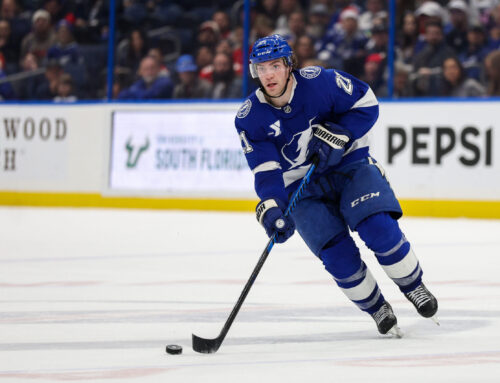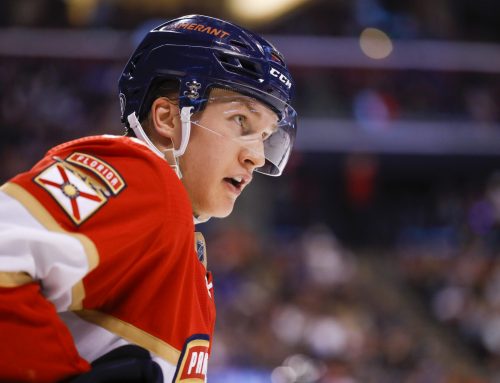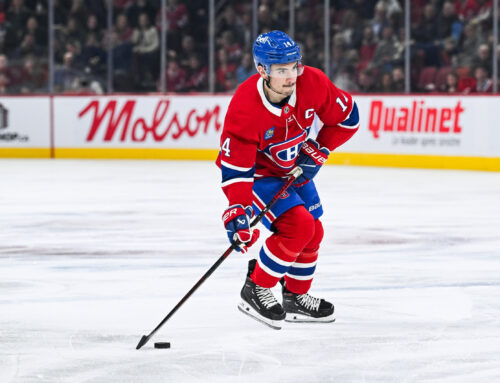
With the halfway point of the regular season having now passed, it’s important to look beneath the surface to identify sustainable – and, arguably even more so, unsustainable – patterns emerging for skaters. That’s where this column comes in. For first time readers or those needing a refresher, the column is a play on the Goldilocks and the Three Bears story, except instead of there being three bowls of porridge I’m covering three skaters and declaring one too hot (i.e., doing unsustainably better than he should), another too cold (i.e., doing unsustainably worse), and a third “just right” (i.e., producing where he should be). I also assign each a rating of 1-10, indicating just how hot (rated 7-10, where 10 is the most unsustainably hot), or how cold (rated 1-4, where 1 is the most unsustainably cold), or how “just right” (rated 4-7, where 5.5 is the most “just right”) he is.
The three skaters being covered this week are Mika Zibanejad, Teuvo Teravainen, and Sami Vatanen. Put on your thinking caps to try and decide which of the three is too hot, which one is too cold, and who is “just right.” After you’ve locked in your guesses, read on to see how many you got right.
Mika Zibanejad
Still just 26, Zibs seems older because he’s been an NHL regular since he was just 19. For a while, it looked like he might fall short of expectations for a sixth overall pick, as he’d scored at a 51-54 point pace for three straight seasons spanning his last campaign in Ottawa to his first two in the Big Apple. Then in 2018-19, he climbed to 74 points, prompting poolies to wonder if he’d truly arrived. Now, despite missing time due to injury, he’s doing even better, scoring at 90-100 point pace for 2019-20. And guess what – signs point to him being able to maintain this production rate.
Looking at Zibs’ stats, he is sporting a career-high in personal shooting percentage. The key though is he’s shooting more than in any past season (almost half a shot more per game); so even if his shooting percentage drops, his scoring rate still should stay nearly as high due to the increased SOG volume.
And SOG isn’t the only area where he’s seeing a healthy gain, as his overall and PP ice times are both higher than last season, with the latter up nearly a full minute thanks in large part to the Rangers were tied for the fifth most PP opportunities among all NHL teams and Zibs taking the ice for two-thirds of his team’s PP minutes. The results are Zibs’ PP Time per game is among the top 16 forwards in all of the NHL, with many ahead of him seeing the ice for even more than two-thirds of their teams’ PP minutes, giving Zibs room to realistically improve in that area. Therefore, we should look for Zibs to continue to rack up PP minutes, and, in turn, PPPts, padding his point total in the process.
At first, there could be reflexive concern that Zibs’ IPP is 81.4%, which is normally a high rate; but if we look at his trends over the past three seasons, it rose from 58.7% to 66.7% to 75.5% last season., so a further increase this season to 81.4% is not unreasonable nor, as such, unsustainable. There’s also the fact that his team shooting percentage marks a career-high, yet that is likely influenced by his personal shooting percentage and a by-product of his further breakout. His 47% OZ% is lower than usual for such a high scorer; but a good bit of that is due to him being deployed regularly on the PK, where, it should be added, he has five points; so unlike with most, it’s not a purely unproductive time for him.
If these were all the stats we had to go by, I might be inclined to predict that Zibs’ production rate could slip; however, there are a huge key we’ve not touched upon – secondary assists. Out of his 35 points, all but four have been goals or primary assists. Yes, it does show to some extent he’s the key to scoring when on the ice, thus reducing chances for secondary assists; but that’s about as impressive a primary points rate as there is, lending further credibility to his increased IPP and all but assured – even if his supporting cast isn’t as skilled as him – that he’ll find his way into more points via secondary assists as the season goes on. And when I say more, I mean enough to compensate for whatever added points he might’ve been receiving via his increased shooting percentage.
So although I’m drawing from a smaller sample size than most players due to Zibs missing time earlier this season, and there’s the reality that only once has he ever scored at a pace higher than 54 points, I think the goals and primary assists rate is so important that what we’re seeing this season is the real deal, so he gets a JUST RIGHT assessment and a rating of 6.0 to account for him perhaps slipping to a 90 point pace. But make no mistake – he’s become a truly elite centerman who can essentially produce his offense regardless of the players with whom he takes the ice.
Teuvo Teravainen
Thus far if you’ve hitched your fantasy wagon to TT, you’ve been increasingly happy with each passing season, as his point totals over the past four campaigns have been 35, 42, 64, and 76. For 2019-20 thus far he’s been right at or near a point per game, which would mark his lowest season-to-season increase; so does that mean, at 25, he’s reached his realistic ceiling? Based on the numbers/metrics, the answer seems to be no, as when the dust settles on 2019-20 he should be at 85-90 points.
Looking first at shots, after never having topped the 182 SOG mark in any previous campaign TT is on pace to exceed that total by 22%. With the added shots one might expect his shooting percentage to dip; however, it stands at 7.2%, or barely over half what it was in the past two seasons. So chances are one of two things occurs – he shoots a bit less and his shooting percentage rebounds, or he keeps his current pace and gets more lucky bounces, since of the 38 forwards who’ve taken more shots only three sport a shooting percentage lower than 8.1%, and they’re all in the top 18 for SOG overall.
In terms of ice times, he’s also seeing healthy gains. In fact, his overall and PP ice times have mirrored his scoring in that those too have increased in each of the past three seasons; and lo and behold both are on track to climb again for 2019-20, with his increase in overall TOI set to be the largest of any full season to season gain and his PP TOI putting him on the ice for more than 3:00 per game and nearly two-thirds of his team’s man-advantage minutes. Overall, these numbers suggest he should surpass his 76 points from last year by more than he’s on track for thus far.
So far so good; but what about his luck metrics? If anything, those bolster the case that he’s on tap for well better numbers over the rest of this season. His team shooting percentage is lower than it’s been the past two seasons, likely dragged down by his personal shooting percentage, while his OZ% is well higher than last season and his IPP is sitting at a full season low. Yes, his IPP is likely somewhat lower because he’s playing more with talented players; but with his SOG and ice time rates increasing, his IPP should at worst stay in neutral or slip by less.
Collectively these metrics present a clear-cut case that Teravainen is due for better numbers from here on out. And in the end, with best ever SOG and ice times, solid luck metrics, and his history of year to year improvement, Teravainen is TOO COLD and gets a rating of 2.55, as I expect him to score at a rate that puts him right near 85-90 points for the season, with a shot at perhaps exceeding that next season as he – and the team around him – continue to get even better.
Sami Vatanen
Landing in the NHL for good in 2013-14 at age 22, Vatanen was thought to be on a fast track to stardom after posting 75 points in 138 games in his first two full seasons on the Ducks, for a higher collective per game scoring rate over those seasons than the likes of Alex Pietrangelo and Torey Krug, among others. Since then, however, Vatanen has not come close to posting even a point per every other game in a campaign, until starting very strong this season. Has he found his footing once again, or is he perhaps making a late leap to the next level? Try neither, as his metrics suggest he’s overachieving, and by a pretty good amount.
At first glance, his baseline numbers don’t seem to support his production spike, as although he’s on track for over two SOG per game, that’s a rate he posted in both good and bad prior seasons. Also, his overall TOI and PP TOI likewise are tracking what he received in prior productive and non-productive campaigns. In other words, nothing here suggests he should be producing at his current rate, especially with the 2019-20 Devils scoring goals at a per-game rate below that of more potent Ducks teams from earlier in Vatanen’s career.
Digging deeper only raises more concerns. For one, of Vatanen’s 22 points 12 (or 54%) have come via secondary assists. To put that in perspective, no player in the entire NHL with more points than Vatanen has a higher percentage of secondary assists and just two (Oscar Klefbom and Nicklas Backstrom) have more points and a secondary assists rate above 50%. While it’s not uncommon for as much as 35-40% of a defenseman’s points to come via secondary assists (versus goals plus primary assists), this rate is unsustainably high and suggests that Vatanen has lucked into more than a handful of extra points thus far and, in turn, his scoring rate should drop over the rest of the season in the normal course.
Furthermore, Vatanen’s OZ% is essentially unchanged versus his prior three disappointing seasons, yet his IPP is over 45% after not having been even 40% in each of his most recent three campaigns. Yes, his IPP had been higher back in his early career; however, not much has changed this season versus the past three, from OZ% to, as noted above, ice times and SOG, therefore casting doubt on how sustainable his higher IPP could be.
Those skeptical that Vatanen suddenly started to connect the dots at age 28 are right to be dubious, as his scoring rate isn’t sustainable and his recent cold play shows signs of this already happening. Yes, perhaps he slightly underachieved over the past three seasons; but there are too many similarities between his numbers for those campaigns as 2019-20, not to mention his high IPP and astronomical secondary assists rate coupled with New Jersey’s low goal output, for Vatanen to be able to continue producing at this rate. As such, he’s TOO HOT and gets an 8.5 rating.
**
Mailbag questions needed
I’m always in need of questions to answer in my monthly mailbag column. There are two ways for you to get your questions to me – (1) email them to admin@dobbersports.com with “Roos Mailbag” in the subject line, or (2) send me a private message at the DobberHockey Forums with your question (my username is “rizzeedizzee”.





 T.B
T.B STL
STL ANA
ANA BUF
BUF DET
DET NYI
NYI CAR
CAR MIN
MIN PIT
PIT NSH
NSH
